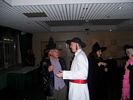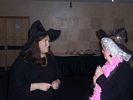Back to Uni to Study Hallowe'en
Glasgow Caledonian University convenes the 1st International Conference on Hallowe'en
It might sound surprising, even anxiety inducing, that any university could want to analyse the fun out of Hallowe'en. But if it was to happen there could be no finer place than Scotland since the pre-Christian Celtic religions of Scotland and Ireland are widely seen as the origins of at least one significant strand of celebrations at this time of year. Yet if the conference 'resolved' little else the disparate contributions from across the globe demonstrated beyond all reasonable doubt that most agricultural societies in the northern hemisphere have long seen fit to feast in their own manner at this time. And there seems no doubt that the Catholic Church aligned its own All Saints, All Souls and St Martinmas celebrations [November 1st, 2nd and 11th] with festivals already ongoing in the Roman world.
Several speakers suggested that this time of year was when agricultural societies slaughtered such of their livestock that could not survive the winter. And that was clearly both an occasion for salting some and for feasting on the remainder! It was like a second 'harvest festival'.
The fascination of comparisons across the northern hemisphere
Speakers at the Conference came from Siberia, Sweden, Denmark, Germany, Slovenia, Italy, Catalonia, Transylvnia in Romania, Isle of Man, the USA, Mexico, Canada, Scotland and England. Some reported no celebrations of Hallowe'en at all until the USA pumpkin driven phenomenon allied to trick and treat arrived. In Germany it was US GIs at Castle Frankenstein and 500 Guiness Irish Pubs. In Siberia and Russia it was the outcome of TV watching by the younger generation post USSR; and the same in Sweden. Its arrival in England was similar although Scotland, the Isle of Man and Ireland all had much stronger Celtic traditions with turnips not pumpkins lighting the way. And in Catalonia roasted chestnuts are eaten in the streets and at home.
Quite uniquely to Catalonia, Italy, Sweden and Mexico was the alternative emphasis on the Festival of the Dead or All Souls' Day. This meant quite literally that time was abrogated and the living and the dead were together again. Extra places were laid at table and meals left outside houses. Most visibly a massive floral tribute was paid across the nation at cemetries in a manner akin to the remembrances that take place each November 11th, St Martinmas Day.
Certainly this pattern of Hallowe'en remembrance fits well with our own activities in Prestonpans as we remember our 81 witches each year. But the tendency in Prestonpans to play down any and all 'fun' arising appears with hindsight to be a contradiction of the wider international interpretation of the time of year when it falls. Perhaps 2007 and beyond should see a more pluralistic celebration alongside the proper remembrances to which we are so strongly committed.
Participants at the Conference took the opportunity at Dinner on October 31st to don typical national attire following a production of The Cauldron from Prestoungrange Arts Festival's 'Meanwhilers' which was extremely well received.
 
Commercialisation by Retailers
No great attention was paid to the rapid commercialisation of the festival of Hallowe'en although Alison D'Amario from Salem described how her city had perhaps become hostage to the fortunes of witchcraft. Many speakers recounted that, after News Year's Day, Hallowe'en was the major festival spending focus, and that extravagant dressing and imagery were now widespread especially across North America. But surely retailers are only able to exploit the latent desire amongst the peoples of Northern Europe for bigtime party time including dressing up, the fearsome side of witches, and ghoulishness, as winter draws in.
___________________________________________________________
Footnote:
Studying the Academic Side of Hallowe'en
by GARY SHAPIRO, Staff Reporter of the New York Sun
November 1, 2006
While many people were celebrating Hallowe'en yesterday, a small group was studying it. A two-day international conference hosted by Glasgow Caledonian University in Scotland examines "all aspects of Hallowe'en as a social, cultural and economic phenomenon," according to the conference web site. "Hallowe'en remains a surprisingly under-researched and under-theorized topic in academic writing."
"There aren't a lot of books on the history of Hallowe'en," an attorney in Bergen County, N.J., Stuart Schneider, who wrote the books "Hallowe'en in America" and "Hallowe'en: Costumes and Other Treats," said. He said it's a fun holiday in which people can engage "in a little mischief."
Asked about the conference, a professor of social and cultural analysis at New York University, Andrew Ross, said Hallowe'en is a "huge industry". Anything that consumes a lot of people's time, energy, creativity, and money "is going to attract scholarly attention."
The conference explores how the pagan holiday, widely held to be of Celtic origin, came to America in the 19th century and then was rekindled in Europe toward the close of the last century.
A professor of European Literature at Queens College, Thomas Bird, said Hallowe'en can be traced to "Samhain Eve," Gaelic for "summer's end." In medieval times, he said, the Church attempted to Christianize the holiday, which became known as "All Hallows' Eve." (The Western liturgical churches celebrate November 1 as All Saints' Day, or the Feast of All Saints followed by All Souls' on November 2nd.)
Published Date: October 31st 2006
|





